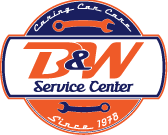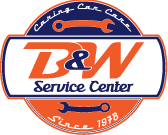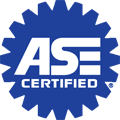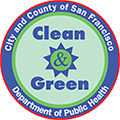Auto Services
-
Mission District Brake Repair
SYMPTOMS
There are a few common signals you might notice when your car’s brakes need to be serviced or repaired:
Squeal
Your brakes squeal when coming to a stop or while driving.
Light
Your brake warning light comes on.
Pulls
Your vehicle pulls to one side when braking instead of stopping in a straight line.
Pulsate
Your car pulsates to a stop when you use the brakes.
Grinding
Your brakes grind continuously producing a loud metallic sound.
Mushy
Your brake pedal is either “mushy” or too hard to press down.
Pump
You must pump the brakes to get them to work right.
Heat
One or more of your wheels are excessively hot after a short drive
Learn more about our brake repair services.
-
Car Air Conditioning Repair
SYMPTOMS
There are a few common signals you might notice when your car’s air conditioner needs a recharge service or repair:
Hot air blowing
This is most commonly due to a refrigerant leak. A quick check you can do at home is to start the car, turn on the a/c and see if the compressor comes on. If it does not, you have an electrical problem or a refrigerant leak. If it does, it is likely that you have a control or circulation issue. Additionally, there could be a control problem causing the heat to turn on.
No air blowing
A blown fuse is often the cause of this problem. Another possible, but rare reason, is a faulty dashboard fan or blower switch. If replacing the fuse does not repair the problem, you will need a certified electrician to diagnose the root cause of the problem.
Strange smell
This problem is characterized by a musty or mildew odor when the fan is turned on. This condition can indicate that mold or mildew is growing in the evaporator box requiring a cleaning procedure to eliminate this smell.
Odd noises
A drive belt makes the air conditioning compressor turn keeping the cooling refrigerant circulating. If the belt is worn, stretched or cracked it can slip or break therefore causing it to make noise or stopping the compressor altogether. When this happens, circulation stops and the air conditioner quits cooling. This can also cause serious damage to other engine systems.
AIR CONDITIONING TERMS
When discussing the automobile air conditioning system some terms and definitions commonly heard are:
Freon (R12)
Freon, also known as R12, was invented in the late 1920’s and then discontinued in the early 90’s when it was found to have a negative effect on greenhouse gases.
R134a
R134a has served as an improved replacement for Freon (R12) since the 1990s because it is environmentally friendly. It is used to charge the air conditioning system in cars.
Compressor
The compressor is the core of your car a/c system. The compressor is a pump hooked to the engine and powered by a belt. Refrigerant is compressed and then turned into a heated gas before being sent to the condenser.
Condenser
The condenser is where the natural heat from the air is bled off by dissipation. The condenser absorbs the heat so that the refrigerant (R134a) can cool down to a liquid form.
Dryer
The dryer is the system filter that removes contaminants and moisture from the refrigerant.
Expansion Valve
The expansion valve is a filter system that controls how much refrigerant is sent to the evaporator. In older vehicles, the refrigerant current is slowed and measured using an expansion valve. When the refrigerant moves through either system, it becomes vaporized and becomes larger in volume, quickly cooling.
Evaporator
The evaporator eliminates heat from the inside of your vehicle. Refrigerant comes in through the bottom of the evaporator as a regular liquid. The warmer air moving through the evaporator blades makes the refrigerant boil. When the refrigerant boils, it gathers a large quantity of heat. This heat is bled off the refrigerant to the outside of the car, leaving cool air which fans blow into the passenger area
-
Car Electrical Repair
SYMPTOMS
There are a few common things you might notice when your car needs electrical repair:
- Battery dies.
- Battery warning light is on.
- Turn signals don’t work or blink too fast.
- Lights don’t dim properly.
- Power windows or mirrors don’t work.
- Burning electrical smell.
-
Car Not Running Right
SYMPTOMS
There are a few common things you might notice when your car is not running right:
Vibration: You feel more vibration than usual in the steering wheel when the vehicle is idling at a stop.
Gas Mileage: You notice that you are filling up at the gas station more frequently than usual.
Check engine light: Your check engine light or service engine light comes on steady or blinking.
Smoke: You see smoke coming from the tailpipe.
These problems are typically a same day repair as long as the vehicle is brought in for care as soon as the problem is observed. Otherwise, unexpected problems can arise adding time and expense to the service visit.
-
Car Overheating
SYMPTOMS
- Temperature gauge reads high.
- Steam or smoke coming from under the hood.
- Check engine light turns on.
- Overheating warning lamp turns on.
- Sweet odor coming from the car..
- Coolant reservoir appears low.
-
Car Steering Repair
SYMPTOMS
There are a few common things you might notice when your car’s steering needs to be repaired or serviced:
- Whining or whirring noise.
- Harder to steer.
- Red or clear fluid leaks.
Keeping your power steering system clean by flushing is the best way to insure against expensive power steering system failures. We recommend flushing the system at least every 50,000 miles.
-
Check Engine Light
SYMPTOMS
A glowing or flashing CHECK ENGINE or SERVICE ENGINE SOON light alerts you to problems in the vehicle’s on-board diagnostic system that should be checked out as soon as possible. Oftentimes you won’t notice a difference in vehicle performance.
Check the Gas Cap
First, check the gas cap to make sure it wasn’t left loose after refueling. Sometimes, this can trigger the light. If the gas cap was left loose, the light should go out after a few short trips. If the gas cap wasn’t the problem and the light remains on, make an appointment to have the vehicle checked as soon as possible.
Flashing
A light that flashes requires more prompt attention as it indicates there is a serious problem that must be checked out immediately to prevent damage to the catalytic converter. When you experience a flashing light, minimize driving at high speeds or under heavy loads.
Emissions Test
In California, any 1996 or newer vehicle will not pass an emissions test if the check engine or service engine light is on.
-
Fluid Leaks from Car
SYMPTOMS
The most common fluid leak symptoms are easy to recognize:
Fluid spot on the driveway
If you see fluid on the ground from your car, it is time to have it inspected. Delaying repairs can greatly complicate the repair process. The only “acceptable” fluid loss from a vehicle is condensation from the a/c system on humid days
A sweet or burning odor
If you smell a sweet or burning odor you almost certainly have a fluid leak. A sweet smell is indicative of an engine coolant leak. A burning smell is usually caused by a fluid leak dripping on the exhaust system.
Smoke from under the hood
Smoke from under the hood indicates an acute leak that requires immediate attention. In some cases, fires have started due to excessive oil leaks on the exhaust system.
You continue adding fluid
Many motorists make the mistake of not repairing the root cause of the fluid loss. All of your vehicle’s systems that use fluids are sealed and designed not to lose fluid. If you are adding fluid, we recommend having one of our service experts inspect your vehicle.
By far, fluid leaks are the most neglected repairs. With older vehicles, fluid leaks were often put off in favor of something more pressing. Now, the price of procrastination is much greater. Today’s vehicles have complex wiring systems and sensors that will be damaged by fluid leaks. Additionally, all front wheel drive vehicles suspend the engine and transmission with rubber-encased mounts. These mounts will break one by one leading to a very expensive repair visit.
-
Fuel Pump Replacement
SYMPTOMS
There are a few common things you might notice when your car needs a fuel pump repair:
- Engine stalls.
- Long crank time to start.
- Lack of power.
- Loud humming noise.
Fuel pumps are a common failure in today’s vehicles. However, they are often misdiagnosed because most technicians do not have access to factory equipment which allows them to pinpoint the exact problem. Modern vehicles have fuel pumps mounted inside the fuel tank, which makes it impossible to look at without dis-assembly. Our service experts are trained to use factory equipment to properly diagnose problems so you don’t waste money having unnecessary repairs performed.
-
Wheel Alignment
SYMPTOMS
There are a few common things you might notice when it’s time for a wheel alignment service:
Pulls
Your car steering “pulls” in one direction. Oftentimes this is caused by a steering angle that is out of adjustment. Sometimes, an under-inflated or faulty tire can cause a phenomena called “radial pull.”
Wandering
You find it hard to keep your car from wandering over the travel lane. A maladjusted caster angle is most likely the cause of this concern. Think of the caster angle like the forks on a motorcycle. The more severe angle on the forks equals more caster. This angle has a great impact on the ability of the car to maintain a straight line.
Play
Instead of feeling in precise control of your steering you feel “play” or “slack” from the steering wheel to the turn of the wheels. Any worn suspension or steering components can cause this problem.
Clunking or rubbing noise
Rubbing or clunking when going over bumps, turning or stopping is a steering and suspension warning. Like slack in the steering, any worn suspension or steering components can cause this problem.
Tire wear
Your vehicle tire wear becomes uneven. A combination of maladjusted steering angles and/or worn components will cause this concern. Sometimes abusive driving or improperly inflated tires can contribute to this problem. This problem is extremely dangerous because the tires prematurely wear exposing a very thin section of the tire to the forces of the vehicle and the road.
Car bottoms out
If your car bottoms out when going over bumps, then worn shocks, struts or suspension components are a likely culprit. We strongly recommend having your alignment checked before any of these repairs are attempted so that all the components can be checked to minimize the possibility of having a repeat repair visit. If you have a strut equipped vehicle, you will need your alignment reset after having your struts replaced.
Replacing tires too often
Maladjusted suspension angles and/or improperly inflated tires are the most common reasons for this problem. In most cases, a proper alignment will fix this problem.
Unlike many under-car garages and franchises, we do not apply generic steering angles to your vehicle. For your benefit, B&W’s suspension experts use our state-of-the-art Hunter Alignment System to properly diagnose suspension concerns. The benefit of this system is that it uses digital cameras coupled with laser trigonometry to achieve the exact steering specifications provided by all of the vehicle manufacturers. When it comes to steering, having a vehicle that handles well will contribute to safety, longevity and enhancement of your driving experience for many years to come. You may say what a lot of our customers do, “It’s almost like driving a new car.”




